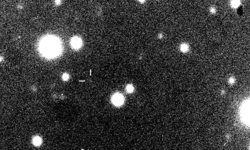Astronomy:Euanthe (moon)
From HandWiki
 Discovery images of Euanthe by the Canada-France-Hawaii Telescope in December 2001 | |
| Discovery[1] | |
|---|---|
| Discovered by | Scott S. Sheppard et al. |
| Discovery site | Mauna Kea Obs. |
| Discovery date | 11 December 2001 |
| Designations | |
Designation | Jupiter XXXIII |
| Pronunciation | /juːˈænθiː/ |
| Named after | Ευάνθη Eyanthē |
| S/2001 J 7 | |
| Adjectives | Euanthean /juːænˈθiːən/ |
| Orbital characteristics [3] | |
| 20799000 km | |
| Eccentricity | 0.232 |
| Orbital period | −602.81 days[2] |
| Mean anomaly | 130.5° |
| Inclination | 148.9° |
| Longitude of ascending node | 271.0° |
| 316.0° | |
| Satellite of | Jupiter |
| Group | Ananke group |
| Physical characteristics | |
| Mean diameter | 3 km |
| Apparent magnitude | 22.8 |
Euanthe /juːˈænθi/, also known as Jupiter XXXIII, is a retrograde irregular satellite of Jupiter. It was discovered by a team of astronomers from the University of Hawaii led by Scott S. Sheppard in 2001, and given the temporary designation S/2001 J 7.[4][1]
Euanthe is about 3 kilometres in diameter, and orbits Jupiter at an average distance of 20,465 Mm in 602.81 days, at an inclination of 143° to the ecliptic (142° to Jupiter's equator) with an eccentricity of 0.2001.
It was named in August 2003 after Euanthe, who was the mother of the Graces, according to some Greek writers.[5]
Euanthe belongs to the Ananke group, retrograde irregular moons that orbit Jupiter between 19.3 and 22.7 Gm, at inclinations of roughly 150°.
References
- ↑ 1.0 1.1 Brian G. Marsden (May 15, 2002). "MPEC 2002-J54: Eleven New Satellites of Jupiter". International Astronomical Union Minor Planet Center. http://www.minorplanetcenter.net/iau/mpec/K02/K02J54.html.
- ↑ "M.P.C. 104798". Minor Planet Circular. Minor Planet Center. 10 May 2017. https://minorplanetcenter.net/iau/ECS/MPCArchive/2017/MPC_20170510.pdf.
- ↑ S.S. Sheppard (2019), Moons of Jupiter, Carnegie Science, on line
- ↑ Daniel W. E. Green (May 16, 2002). "IAUC 7900: Satellites of Jupiter". International Astronomical Union. http://www.cbat.eps.harvard.edu/iauc/07900/07900.html.
- ↑ Daniel W. E. Green (August 8, 2003). "IAUC 8177: Satellites of Jupiter, Saturn, Uranus". International Astronomical Union. Archived from the original on March 27, 2012. https://web.archive.org/web/20120327153049/http://www.cbat.eps.harvard.edu/iauc/08100/08177.html.
 |

